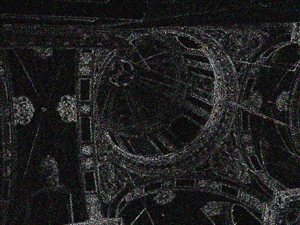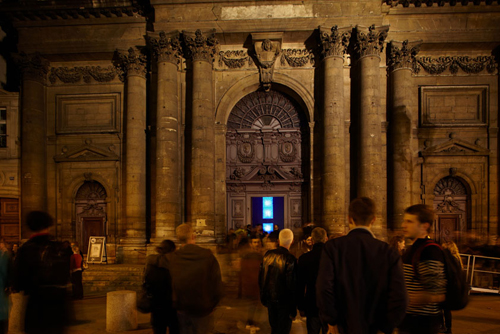10_2010
+++++++++++++++++++++++++++++++++++++++++++++++++++
reflexion!? is an interactive audio visual installation created by Djeff Regottaz, Loïc Horellou and Olivier Pasquet. This interactive piece was premiered for the 2010 Paris Nuits Blanches.
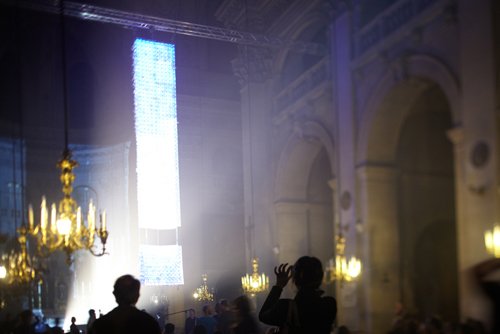 end of the sequence, rear light at full
end of the sequence, rear light at full
The air is full of contemplation and silence. Voice chops continually blare inside the 1641 St Paul church located in the center of le Marais in Paris. Pure tones are so entangled it is difficult to determine their origin; whether they are coming from voices, whispers, or the space itself. They are mixed with the actual sounds of visitors. Sound pressure slowly reaches a loud level until everything suddenly stops; only loud reverberated impacts against the walls remain. At this central moment, a strong light invades the heart of the building.
Beyond the marvelous architectural interest, the foremost visual concentration is a bright exclamation point. That piece made of hundreds of fans floats in the air in the center of the building. Tiny dots projected from a strong video beamer pierce the smoky and lightened air until reaching those fans. Every time a fan receives the light from one of the dots, it starts spinning and gets blue. Music generation, fans, lights, and video projection are tightly synchronized, giving the visitor the impression there is a total fitting with the space.
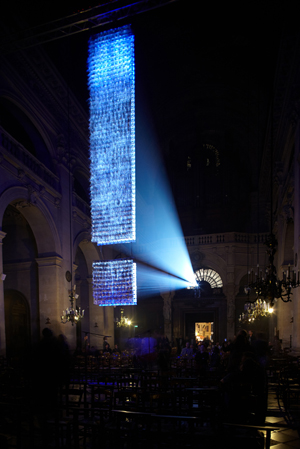 view of the video projector controlling the fans |
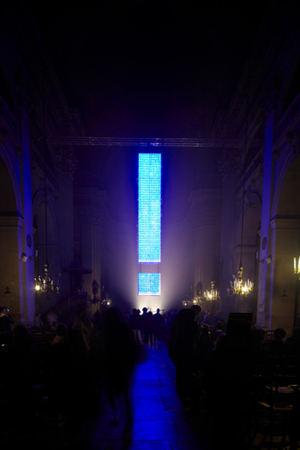 same view from front |
The sound part of Reflexion!? consists of the restructuration of a specific space. A church is an ideal place when silences and whispers are enhanced by reflections. Visitors have very special behaviors in a church. All their talking and movement are reverberated and fill the space far more than usual. One cannot hear what someone says from far away but it is possible to notice someone talking. There are two kinds of families: voice chops and silences from the church building itself.
The bass occasionally embellishes this development. It is some kind of resonator coming from the church itself. The huge size of the building makes it sound like the bourdon of the organ. In 1754, Giuseppe Tartini wrote Trattato di Musica secondo la vera scienza dell’Armonia. His theoretical system incorporates the differential tone (terse suono) which he claimed to have discovered in 1714. It then has been widely used through the centuries.
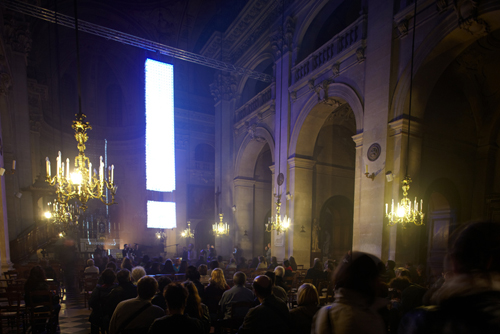 adulatory silences, mics are below the exclamation point
adulatory silences, mics are below the exclamation point
The final minute of the piece ends with an impressive very loud white noise synched with the lighting. This is made from all superposed recorded sounds. This way, space is disintegrated the same way it is done in the voice. The idea is very close to 3d scanning point cloud analysis. See what the scanlabprojects project is doing. Reflexion!? is the restructuration of a specific space because the interactive concept slices and orders chops taken from the space. It is somehow an analysis of the architecture of the church using its sonic response. The reconstruction is done by sending sounds in a musical order and another direction. There is a strong link between architectural 3d scanning and convolution reverbs.
Visitors may pass in front of speakers and discover the process is based on the replay of their own voice and silences. Thus, the invisible and inaudible resonance of the church is revealed by overlay like a ghostly apparition.
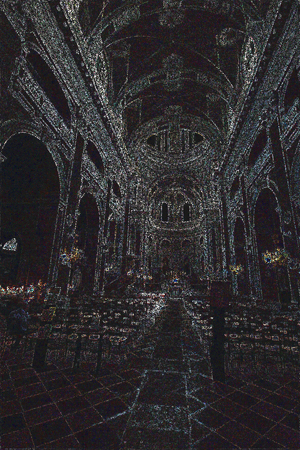 3d cloud-point scanning visualization |
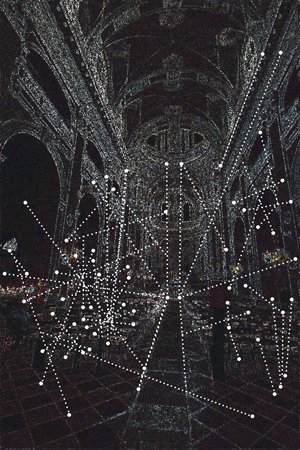 reverberation points |
A bass, or bourdon evoluates until taking the whole space of the building. This bass rises from the resonances of the building in the way of a Larsen effect. Reflexion!? starts with one minute of silence. During this moment two microphones record the space and visitor voices. Using op.recognize, I segment sounds, classify them, and then place them on pre-defined rhythmic grids.
In Kaspar, punctiliousness was perceived using high pitches. This time, tightness is reached using very short slices of sounds. Many sounds are 20 milliseconds long. The fact we are dealing with voice allows very short slices. Physiologic, natural reflexes and habits probably allow our brain to easier recognize voice in a short time and narrow bandwidth. Vibrato is not always needed, allowing even shorter chops. The fact it is voice in extreme conditions gives the opportunity to musically play between sound and meaning. People like poets from the 1980s or theatre music people are often playing with those questions. Maurizio Kagel or Georges Aperghis are good examples. But this time, the fact chops come from a machine permits us to go up to the limits of perception on one side and the limits of meaning on the other side. This is what I was doing in Machinations ten years before Reflexion!?.
Reverberation is an effect giving the visitor the impression of largeness. It also changes timbres and radically changes length for short sounds. The tempo is set in a way visitors can often have a side-chain compression effect. This is what happens when listening to loud music with headphones in a noisy place. Music is heard from headphones until it gets quieter on a downbeat for instance. The outside noisy place is then heard. Repeating this several times per second makes you believe sounds from the outside are part of the music because they are well-synced with the music. This effect is often electronically used in popular music: the level from the kick sets all the other levels down. This way, EQ can be avoided and all sounds have a proper presence. This is musically often used in the style French Touch. For Reflections!? the effect is done acoustically with the reverb from the church thanks to pulsation and voice segments.








